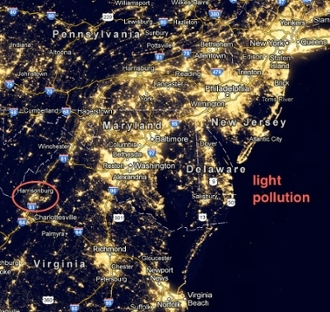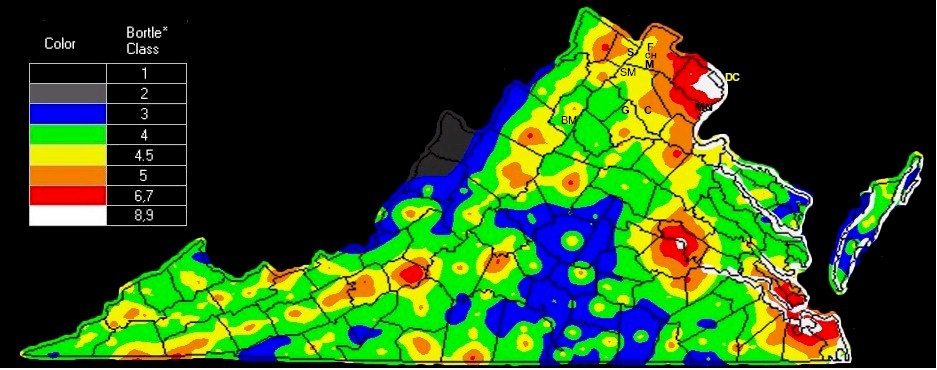"In most cities the sky looks as though it has been emptied of stars, leaving behind a vacant haze that mirrors our fear of the dark and resembles the urban glow of dystopian science fiction." —Verlyn Klinkenborg, Our Vanishing Night
What is Light Pollution?
Out of all the various pollutions humans create, light pollution gets the least attention. But light pollution is one of the most prevalent issues facing the developed and developing worlds today. Light pollution can come in several forms: light trespass is when unwanted light escapes from one property into adjacent properties; over-illumination is using excessive light where it isn't needed; light clutter is the redundant clusters of lighting found in many urban centers; sky glow is the collective light pollution found over big cities. You've seen this on every cloudy night when the sky above Harrisonburg glows yellow from all that light reflected back down to planet Earth. It is an enormous waste of money, of resources, and more importantly, it is harming us.
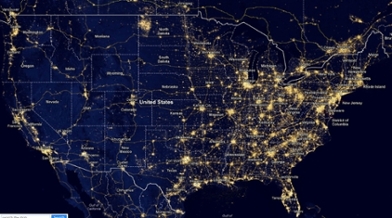
Light pollution across the U.S.
What Causes Light Pollution?
As stated in the National Geographic article Our Vanishing Night [1], light pollution is largely the effects of bad lighting design, which allows artificial light to shine outward and upward into the sky, where it's not wanted, instead of focusing it downward, where it is. Common sources of light pollution include street lamps, parking lot/shopping malll lights, exterior lights found on most homes/businesses, neon signs and illuminated signboards. Indeed, in most images showing the eastern USA at night, you can clearly see the I-95 corridor, the I-81 corridor, as well as each of the cities along these routes.
Effects on Human Health
Darkness is essential to our biological welfare. For centuries before the development of artificial light, human beings had become used to a day/night cycle of 12 hours of natural light and 12 hours of darkness. That cycle is a part of our circadian rhythms, an essential biological imperative which is dramatically affected by the presence of light at night.
According to an article in Sky & Telescope magazine [2], disruption of the circadian rhythm has been linked to sleep disorders like insomnia and delayed sleep-phase syndrome, as well as depression, hypertension, attention deficit disorder, obesity, diabetes, and heart disease.
Another important biological function that is disrupted by the presence of light at night is the production of melatonin. Melatonin is potent anti-oxidant, anti-carcinogen, and is responsible for regulating metabolism, and immune responses. According to a thesis presented to the University of California [3], less than 15 minutes of exposure to bright light at night can completely halt the production of melatonin. Lowered levels of melatonin have been shown to have correlation to to the rising rates of breast cancer amongst the developed world. According to another study, cited in the journal Environmental Health Perspectives [4], women who live in areas where it is bright enough to read a book outside at midnight had a 73% higher chance of developing breast cancer than women living in less brightly lit areas.
Does More Light Make You Safe?
Look around at the kinds of lights used at night. Do you have good visibility around you or does the unshielded light produce so much glare that you in fact have poor visibility? It's typically the latter. The safety-related dangers that come with poor visibility at night are caused by glaring lights. But there are easy solutions: shielding lights to reduce glare, dimming lights to provide the right amount of light, and turning off lights when they’re not needed. Have a look at the image below. Do you see the intruder standing in the pathway in the left image? In the right image, all the photographer does is use his hand to cover up the light, exactly what a properly shielded light fixture would do. Do you now see the intruder standing in the pathway? More light doesn't make us safer! Smarter use of light does!
Effects on Wildlife
But humans aren't the only creatures affected by light pollution. Wherever human light spills into the natural world, some aspect of life for animals—migration, reproduction, hunting and feeding—is affected.
The most well studied incidence of this can be seen in the case of sea turtles. Sea turtle hatchlings instinctively know to head toward the brightest source of light, because for hundreds of years before mankind mastered the darkness, starlight reflecting off the ocean was the brightest thing on the beaches. But with coastal cities flooding the night with their bright lights, the hatchlings become confused and disoriented, heading toward the cities and not the sea, falling prey to dehydration and predation and never reaching safety of the ocean. Hatching losses in Florida alone number in the hundreds of thousands each year. [5]
Effects on the Economy
While the environmental effects of light pollution are tragic, the economic effects can be just as shocking. The International Dark-Sky Association estimates that 1/3 of all lighting is wasted at an annual cost of $2.2 BILLION dollars. The light projected directly upwards from a cobra-head streetlight is about 30% of the total light it emits! To put that in perspective, the average desk lamp use 40 watts of electricity. To generate so much electricity, predominately coal-fueled power plants expel around 15 million tons of carbon dioxide pollution to the atmosphere each year. [6] So much air pollution results from the creation of electricity that fixing light pollution would be the equivalent of removing 9.5 million cars from the roads.
"Dark sky" does not mean "dark ground"; if you're smart, you can have a dark sky without losing light on the ground.
But Wait! Where -I- live, the skies are DARK!
We simply do not see the night time sky in much of the continental USA as our predecessors saw it just 2 generations ago. To make this case, have a look at the two images in this section.
The first image below shows Harrisonburg, Staunton, Waynesboro, Charlottesville, Shenandoah National Park etc. In this image, taken from a space-based satellite in 2012, you can see the enormous light footprint of our cities and towns. You may look at an image like this and perhaps you say, "Yeah, those big-city folks in Harrisonburg, Staunton, Charlottesville really don't see any stars." Which is true, and by comparison to your sky where you live in one of those darker areas, you see many more stars than we do. BUT what an image like this fails to capture is the overall sky brightness because of poorly designed light fixtures that produce light pollution.
In the second image, you see how bright the skies are over Virginia and how this is measured. This sky brightness measurement is referred to as the "Bortle Scale" where a high number is bad. For instance, the night sky in Times Square would be a 9 -- you wouldn't see any stars from that location. By comparison, the cities of Harrisonburg, Staunton, Waynesboro, Charlottesville is a "5", meaning bright skies where you effectively see nothing but the brightest stars. More alarmingly, the skies above Shenandoah National Park, ranks as a '4'. So, yes, better than Charlottesville, better then Staunton, better then Harrisonburg, in that you do see more stars and you may even see the faint nebulosity of the Milky Way Galaxy, BUT it is nowhere near as dark (and the Milky Way as bright!) as our predecessors saw it just 2 generations ago.
As we start heading west into West Virginia, and Shenandoah Mountain and the George Washington National Forrest, we start finding sky brightness drop to about "2" on the Bortle scale (see image below for the quality of our night sky changes as the Bortle Classification changes). This about the darkest skies you will find anywhere on the eastern seaboard now and even those dark skies are in endanger of being lost due to plans for development, fracking, etc.
One story that Paul Bogard, author of the critically-acclaimed book "The End of Night: Searching for Natural Darkness in an Age of Artificial Light", likes to relate when he began the research for his book, is that he asked the National Park Service where in the USA he would need to go to experience really dark skies, like a Bortle Class 1 sky. Their response? Australia.
Our night sky is very bright everywhere. And unless we do something, we will slowly erase all the stars from our night sky, even where you live.
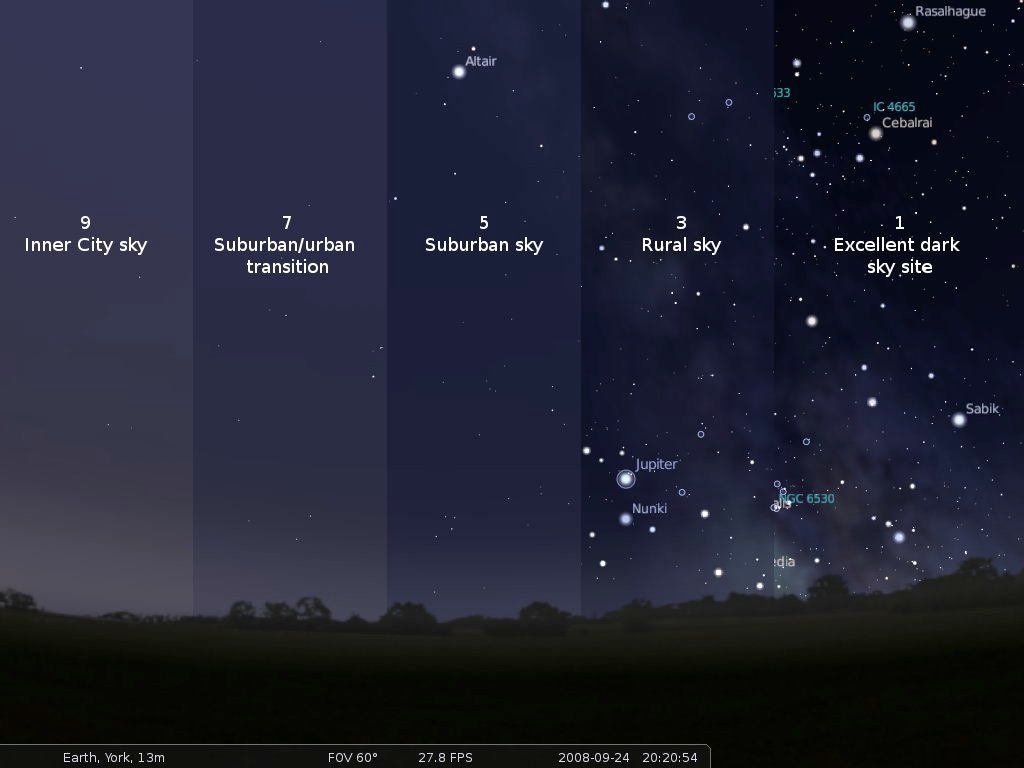
How Can We Fix Light Pollution?
The most effective fix to light pollution is to turn OFF the lights! If you canNOT, then use fully shielded, light effcient fixtures as they prevent light from being wasted outside of the space you desire to be lit.
Fully shielded light fixtures prevent light from traveling above the horizontal, stopping light from traveling up into the sky and greatly reducing sky glow. Research shows that 75% of artificial sky brightness comes from light escaping directly from fixtures, implying that replacing current fixtures with fully shielded one would reduce sky brightness to one-fourth of its current levels, not to mention the savings on your electrical bill.
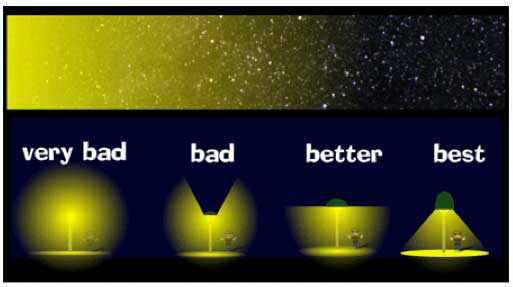
For More Information
Visit the John C. Wells Planetarium for one of free Saturday afternoon public shows or visit the website of the International Dark-Sky Association (darksky.org) to find out what you can do to help reduce light pollution in your area!
Searching for a movie? See THE CITY DARK! Better yet, you can read the book, "The End of Night: Searching for Natural Darkness in an Age of Artificial Light," by JMU Assistant Professor of English, Paul Bogard. Published in July 2013 by Little Brown, the book blends personal narrative, natural history, science and history to shed light on the importance of darkness; what we've lost, what we still have, and what we might regain and the simple ways we can reduce the brightness of our nights.
Sources
-
Klinkenborg, Verlyn. "Our Vanishing Night." National Geographic 214.5 (2008): 102. MAS Ultra - School Edition. Web. 3 Apr. 2012.
-
Parks, Bob. "The Battle To Control Light Pollution." Sky & Telescope 122.3 (2011): 30. MasterFILE Premier. Web. 6 Apr. 2012.
-
Ashraf, Cameran Hooshang. Light Pollution: The Problem and its Significance. California State University, Fullerton, 2009 United States — CaliforniaProQuest Dissertations & Theses (PQDT). 7 Apr. 2012.
-
Chepesiuk, Ron. "Missing The Dark." Environmental Health Perspectives 117.1 (2009): A20-A27. OmniFile Full Text Mega (H.W. Wilson). Web. 8 Apr. 2012.
-
The City Dark. Dir. Ian Cheney. Perf. Ian Cheney. Wicked Delicate Films, 2012. DVD.
-
International Dark-Sky Association. Practical Guide to Light Pollution. Tucson, Arizona: International Dark-Sky Association, 2011.

